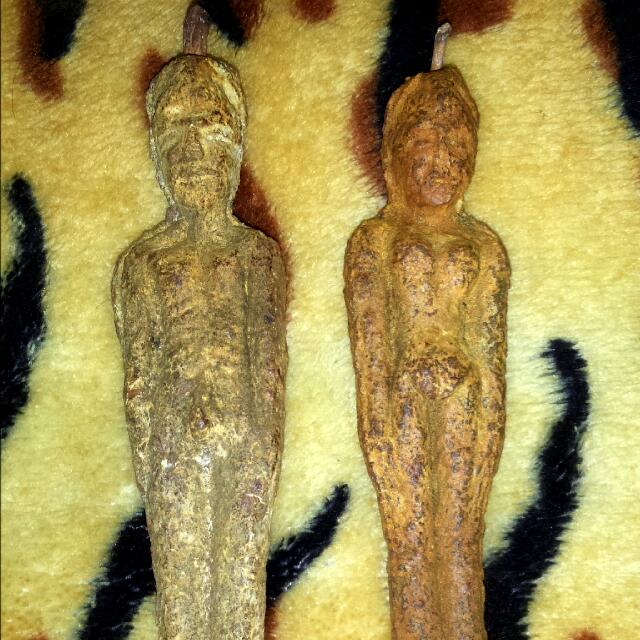- Many people apparently believe that the Nareepol Tree and its improbable fruit (or flowers) really exists and, although they have never seen it “in the flesh” (so to speak), some have even come to regard it as a sacred object. However, the Nareepol Tree is almost certainly nothing more than a hoax.
- Nareepol are fruit maidens that grow from trees according to Thai Buddhist mythology. The fruit last only 7 days, so hermits quickly carry them off for some hanky-panky in the forest.
- Real fruit is likely to vary considerably in size, hue and quality, even when growing on the same tree.The description of the Nareepol Tree and the photographs of its 'fruit' are amusing and the message is basically harmless so long as recipients do not take its claims seriously.Last updated: 1st April 2008First published: 1st April 2008Write.
The temple's market sells these fertility charms as fruit grown from the blessed Nariphon tree of Buddhist mythology. This sacred tree, alternatively called the Makkaliphon tree or Nareepol tree, is said to grow fruit in the shape of a woman. Nariphon literally translates as 'fruit woman'. Thai scripture states. Nareepol Tree - Hoax-Slayer. According to this fanciful message, which is making the rounds of the Internet via email and social media sites, the accompanying photographs depict an amazing tree in Thailand that grows fruit in human shape. Article by Hoax-Slayer.

Thai lacquerwork painting of the Naripon tree at Phra Pathom Chedi | |
| Grouping | Mythical tree Legendary creatures |
|---|---|
| Sub grouping | Sylvan |
| Region | Southeast Asia |
The Nariphon (Thai: นารีผล, from Palinārīphala), also known as Makkaliphon (Thai: มักกะลีผล, from Palimakkaliphala), is a tree in Buddhist mythology which bears fruit in the shape of young female creatures. The maidens grow attached by their head from the tree branches.[1] This tree grows at the Himaphan, a mythical forest where the female fruits are enjoyed by the Gandharvas who cut the fruits and take them away.[2]
The Nariphon is also mentioned in the Vessantara Jātaka in which Indra placed these trees around the grove where the Bodhisattva Vessantara meditated.
Myths and folklore[edit]
According to Buddhist mythology, the god Indra created a pavilion (Sala) as an abode for Vessantara, his wife, and two children to live. His wife went into the forest to collect fruits: she was, however, in danger of being attacked by hermits or yogis who lived in the forest. Although they had acquired special powers from their meditation, they had not conquered lust.
Therefore, Indra created twelve of these special Nariphon trees. The trees would bear fruit whenever she went out to collect food and distract the men. The fruits were all in the image of Indra's beautiful wife. The men took the fruits to their place of abode and, after making love to them, would sleep for four months and lose their powers.
According to Thai folklore, since Vessantara and his family have died, the trees bear fruit daily, but the forest will disappear when the Buddha's teachings have become lost (predicted to be five thousand years after his death). When the fruits appear on the trees, they last for seven days, after which they will wither and die if they are not picked.[3] Salt and sanctuary crack. They have same internal organs as humans, but no bones. These maidens also have magical powers and possess spirits which can sing and dance.[4]
There are supposedly two Makaliporn pods in a Buddhist temple near Bangkok. Ptmg v2 and v2.1 patch for gta san andreas. It is said that they came from Himaphan, the mythical forest.[5] At Wat Pheut Udom temple near Pathum Thani there is a representation of the tree together with ghosts and hell-scenes.[6][7]
Representations of the Nariphon tree are very common in Thai comicbooks, both fresh[8] and dry, often in manga style.[9]Amulets and charms in the form of Nariphon girls are sold throughout Thailand.[10] Folk stories claim that the tree grows somewhere in the Phetchabun Mountains and hoaxes are common; these include pictures of Nariphon girls growing from trees[11] as well as dry Nariphon maidens.[12]
The Nariphon myth inspired the 2006 Thai filmNariphon (นารีผล, 'Devil Ivy'), with Chayanan Arjpru, Tassachol Pongpakawat and Paymanee Sangkakorn,[13] and 2010 movie Nariphon Khon Phrueksa (นารีผล คนพฤกษา, 'Nariphon, People from the Tree'), with Phasakon Phomrabut and Thanmon Theklamlong.[14]

Nareepol Fruit
See also[edit]
Nareepol Tree Wikipedia Fruit
References[edit]
- ^Nariphon Tree at a temple in Thailand
- ^Thai traditional mural paintingArchived 2015-01-30 at the Wayback Machine
- ^Nariphon book
- ^มักกะลีผลหรือนารีผล น่าจะเป็นเรื่องในชาดกเท่านั้นหรือ
- ^The Amazing Makkaliporn of Wat Prangmuni
- ^พบกับสวรรค์และนรกได้ที่ วัดพืชอุดม จ.ปทุมธานี
- ^เที่ยวนรก-สวรรค์ที่วัดพืชอุดม ลำลูกกา ปทุมธานี
- ^'Comic Vignette'. Archived from the original on 2016-03-04. Retrieved 2012-09-09.
- ^'Manga Comic picture'. Archived from the original on 2012-02-05. Retrieved 2012-09-09.
- ^Nariphon Amulet
- ^Hoax slayer - Nareepol Tree
- ^Thailand Naree Pon Flower Pod Elf Women Fairies
- ^นารีผล, Devil Ivy
- ^นารีผล คนพฤกษา 'Nariphon, People from the Tree'
Nareepol Tree Fruit

External links[edit]
| Wikimedia Commons has media related to Nariphon. |
